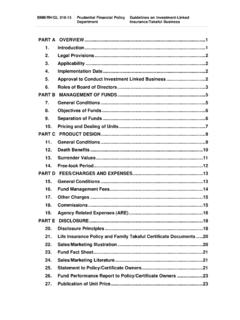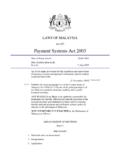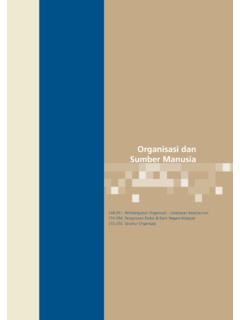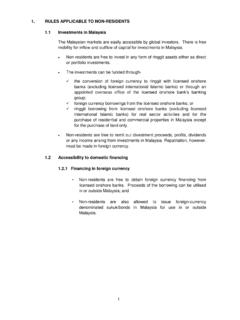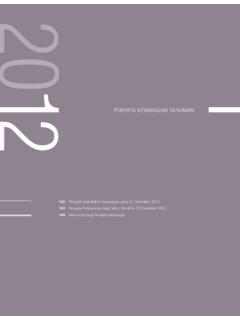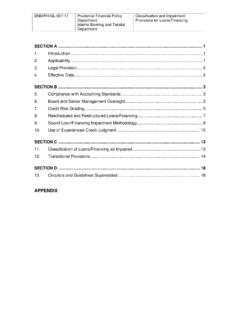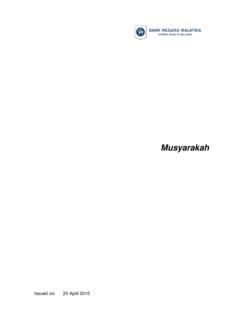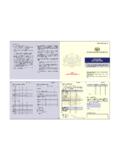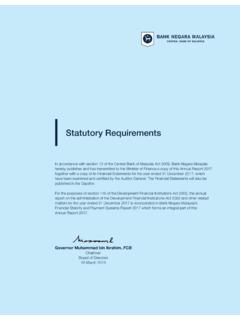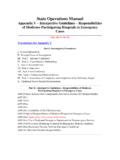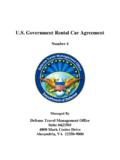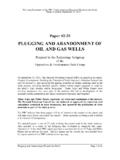Transcription of PART A OVERVIEW1 1. INTRODUCTION1 2. OBJECTIVE1 3. …
1 PART A : 1. 2. 3. 4. 5. 6. LEGAL PART B : OPERATIONAL 7. PRINCIPLE 1: ESTABLISH ADEQUATE GOVERNANCE AND OPERATIONAL 8. PRINCIPLE 2: ENSURE PROPER RISK MANAGEMENT IS IN 9. PRINCIPLE 3: ENSURE THAT THE RISKS OF USING E-MONEY, AND RIGHTS AND RESPONSIBILITIES OF ALL STAKEHOLDERS ARE CLEARLY DEFINED AND 10. PRINCIPLE 4: ENSURE PRUDENT MANAGEMENT OF 11. PRINCIPLE 5: ENSURE TIMELY REFUND OF STORED VALUE IN THE 12. PRINCIPLE 6: IMPLEMENT ADEQUATE MEASURES TO PREVENT THE USE OF E-MONEY FOR MONEY LAUNDERING, AND ENSURE COMPLIANCE WITH OTHER 13. PART C : SPECIFIC REQUIREMENTS FOR LARGE E-MONEY Appendix Appendix Appendix BNM/RH/GL 016-3 Payment Systems Policy Department Guideline on Electronic Money (E-Money) Page 1/17 PART A : OVERVIEW Electronic money (e-money) is a payment instrument that contains monetary value that is paid in advance by the user to the e-money issuer.
2 The user of e-money can make payments for purchases of goods and services to merchants who accept the e-money as payment. E-money can be issued in different forms, such as card-based ( prepaid card) and network-based which can be accessible via the internet, mobile phones or any other devices. There are two types of e-money schemes, small scheme and large scheme, which is determined by the purse size and the outstanding e-money liabilities. The main regulatory objective in overseeing e-money operations is to promote the safety and soundness of e-money schemes, and therefore enhance users confidence in the usage of e-money. Although a failure or disruption in e-money schemes is unlikely to cause financial system instability, it may have an adverse impact on public s confidence in electronic payment instruments.
3 Therefore, prudent and safe management of e-money schemes is crucial to ensure wider acceptance and success of electronic payment modes. This Guideline outlines the broad principles and minimum standards to be observed by e-money issuers in relation to the operation of their e-money schemes. 1. INTRODUCTION 2. OBJECTIVE BNM/RH/GL 016-3 Payment Systems Policy Department Guideline on Electronic Money (E-Money) Page 2/17 This Guideline stipulates the operational requirements for all e-money issuers (Part B) and specific requirements for large e-money issuers (Part C). This Guideline is applicable to all e-money issuers in Malaysia, including licensed institutions. However, Part C is only applicable to issuers of large e-money schemes that are not licensed institutions.
4 E-money issuers are required to adopt the principles and the minimum standards in this Guideline, taking into consideration the nature, size and complexity of their e-money schemes. For the purpose of this Guideline, the following terms are defined as follows: E-money is defined in the Payment Systems (Designated Payment Instruments) Order 2003 as a payment instrument, whether tangible or intangible that: i. stores funds electronically in exchange of funds paid to the issuer; and ii. is able to be used as a means of making payment to any person other than the issuer. Issuer of e-money refers to any person that is responsible for the payment obligation and assumes the liabilities for the e-money being issued. User refers to any person to whom the e-money has been issued or any person who uses the e-money to make payments for purchases of goods and services.
5 Merchant refers to any person that accepts the e-money as payment for their goods and services. 3. SCOPE 4. APPLICABILITY 5. DEFINITION BNM/RH/GL 016-3 Payment Systems Policy Department Guideline on Electronic Money (E-Money) Page 3/17 Reload agent refers to any person that accepts payment on behalf of the issuer for the purpose of adding monetary value to the e-money. Purse limit means the maximum monetary value that can be stored in an e-money instrument. Licensed institution refers to any person licensed under the Banking and Financial Institutions Act 1989 (BAFIA), Islamic Banking Act 1983 (IBA) and Development Financial Institutions Act 2002 (DFIA). Outstanding e-money liabilities refer to the unutilised amount of e-money which has been issued and the utilised amount of e-money which is pending payment to merchants.
6 Large e-money scheme refers to e-money scheme with: i. Purse limit exceeding RM200 The maximum purse limit for large scheme is capped at RM1,500 or any amount as approved by the Bank; or ii. Outstanding e-money liabilities1 for 6 consecutive months amounting to RM1 million or more. Small e-money scheme refers to e-money scheme with: i. Purse limit not exceeding RM200; and ii. Outstanding e-money liabilities of less than RM1 million. This Guideline is issued pursuant to Sections 25 and 70 of the Payment Systems Act 2003 (PSA). Issuers of e-money are required to obtain approval from Bank Negara Malaysia (the Bank) pursuant to Section 25(1) of the Payment Systems Act 2003. 1 Average outstanding e-money liabilities for the month.
7 6. LEGAL PROVISIONS BNM/RH/GL 016-3 Payment Systems Policy Department Guideline on Electronic Money (E-Money) Page 4/17 An issuer of e-money shall be a company incorporated under the Companies Act 1965. PART B : OPERATIONAL REQUIREMENTS An issuer of e-money should establish adequate governance arrangements, which are effective and transparent, to ensure the continued integrity of its e-money scheme, which include, among others, the following: A board of directors and management that consists of people with calibre, credibility, integrity, and fulfil the fit and proper criteria as stipulated in Appendix I. The major responsibilities of the board are outlined in Appendix 2. Clearly defined and documented organisational arrangements, such as ownership and management structure.
8 Segregation of duties and internal control arrangements to reduce the chances of mismanagement and fraud. An issuer of e-money should establish adequate operational arrangements for its e-money scheme, which include the following: i. Rules and procedures setting out the rights and liabilities of the issuer and the user, and the risks the user may incur; ii. Measures to ensure prudent management of the funds collected from users, including measures to ensure that such funds are available for repayment to users; iii. Measures to ensure safety, security and operational reliability of the e-money, including contingency arrangements; and iv. Maintain separate records and accounts for its e-money activities from other business activities 7. PRINCIPLE 1: ESTABLISH ADEQUATE GOVERNANCE AND OPERATIONAL ARRANGEMENTS BNM/RH/GL 016-3 Payment Systems Policy Department Guideline on Electronic Money (E-Money) Page 5/17 An issuer of e-money should establish appropriate risk management infrastructure and processes for its e-money operations.
9 The issuer should ensure that its systems have adequate security and internal controls to ensure the safety and integrity of the e-money data and records, effective fraud detection and resolution mechanism, and proper risk management arrangements. Robust and well-tested contingency arrangements should also be in place to address operational disruptions. Issuers should implement operational and security safeguards which commensurate with the scale and complexity of their schemes. Operational risk Operational risk arises from the potential for loss due to inadequate or failed internal processes, people and systems, external factors, and fraud. A high level of system availability is required to maintain public confidence. Issuers have to ensure that they have resources and capacity in terms of hardware, software and other operating capabilities to deliver consistently reliable service.
10 Measures to ensure operational reliability include, but are not limited to, the following: i. The system is robust in its design, development, testing, implementation and monitoring; ii. Strong internal controls for systems and personnel administration; iii. Comprehensive and well-documented operational and technical procedures to ensure operational reliability; iv. System should be designed with sufficient capacity, which is monitored and upgraded ahead of business changes; 8. PRINCIPLE 2: ENSURE PROPER RISK MANAGEMENT IS IN PLACE BNM/RH/GL 016-3 Payment Systems Policy Department Guideline on Electronic Money (E-Money) Page 6/17 v. Robust clearing and settlement arrangements to ensure that the system will operate in an efficient, reliable and secured manner; vi.
